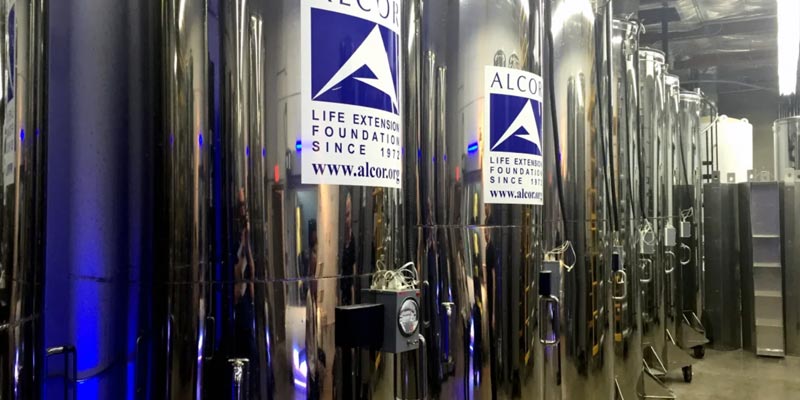Cryonics is freezing and storing a body after death with the hope that technology of the future will be able to resurrect those who have passed. While the technology has yet to be invented and no one has been brought back to life yet, people are willing to pay serious money for cryogenically freezing with the dream of copying the storyline of Captain America and awakening one day again in the future.
How does cryonics work?
Stage one: First the emergency response team preps the body
When an individual is legally pronounced dead, an emergency response team from the chosen cryonics facility will collect the body as quickly as possible and bring it immediately to the cryogenics facility. The team will pack the body in ice, give the dead body oxygen and inject a chemical like Heparin to prevent the blood from clotting. Limiting the time between death and the emergency team prepping the body for freezing is crucial as decomposition of the body starts around four minutes after a person dies.
Stage two: Being admitted to the cryogenic facility
Once the body arrives at the cryogenic facility, the freeze team will start replacing the blood with cryoprotectant, a chemical compound that acts as an antifreeze to protect cells and tissues from damage due to freezing. As human body cells are mostly water, it’s important to prevent ice forming in the cells as they can expand and break leaving broken cells that are rendered useless, decreasing the chances of an individual being revived one day.
The cryoprotectant is patent specific per facility and especially designed to prevent loss of cells. The most common chemical compounds that can be found in current cryoprotectants concoctions are Glycerol, Formamide, Methanol and Dimethyl Sulfoxide.
Glycerol is the least toxic solution and an industry favorite since 1949 when it was used to successfully freeze sperm from birds, an experiment that laid the foundation for further development of the popular frozen technology in vitro fertilization.
When Glycerol solution is added to cells in a test tube water leaves the cells as Glycerol enters the cells through the process of osmosis. During freezing, Glycerol will form hydrogen bonds with water, interfering with water molecules interacting with each other thus preventing ice crystals from forming.
When the body is fully prepped it is placed into a capsule and submerged in liquid nitrogen at a temperature of about -196 degrees Celsius or -346 degrees Fahrenheit. This is where the body will remain until there is a possibility to revive it.
Stage three: Reviving the body
As of today this step remains to be proven possible. No cryogenically frozen individual has been revived and no attempts have been made because with today’s technology it is impossible to remove the cryoprotectant and rehydrate the body in a way that would resurrect a frozen individual.
Using the best cryogenic technology available right now, if one million skin cells were frozen in liquid nitrogen, and then tested after a year, you would see that hundreds of thousands of the cells had already died within the first few days of de-freezing. This happens because the process of freezing uses multiple chemicals and when de-freezing is implemented it destroys the structure of proteins and the DNA inside a cell, which are essential for life.
Will cryogenics ever work?
A lot remains unclear what happens when the body dies. Everyone knows at least one story of someone who died and was brought back to life with the help of resuscitation or an AED device. BBC recently did an amazing expose about seven Danish children who fell through the ice, were trapped underneath for a significant amount of time, clinically diagnosed dead only to be brought back to life a few hours later, with no known effects on their body. The brain is a mysterious thing and there is no specific duration of clinical death at which the non-functioning brain clearly dies.
How many bodies are cryogenically frozen and what are their chances of revival?
There only three facilities worldwide that provide cryopreservation services, three are located in the USA and one is located in Russia. The exact number of bodies being cryogenically frozen internationally is not clear, however Alcor Life Extension Foundation, one of the service providers, chooses to be transparent about their organization. At Alchor there are 1,736 members of which 176 are already cryogenically frozen. Of this group, 108 have had their head frozen and 58 have their whole body frozen.
Worldwide it is estimated that no more than a thousand people are cryogenically frozen and that’s because Cryonics comes at a price. Ranging from $30.000 for the freezing of a head up to $200.000 for a full body freezing.
So what if cryogenic technology worked and people would be brought back to life?
Let’s say cryogenic technology cracks the code and can bring cells back to life. It’s not clear what would even be possible to bring back, since the body was frozen in a dead condition. So the quality of the brain and body refunctioning again is questionable. Popular belief falls to transferring the consciousness or the brain itself into newly produced body or a robotic body. The fear of death and the desire for immortality continues to drive the re-animation industry and will continue to be a curious idea to ponder and keep an eye on.
